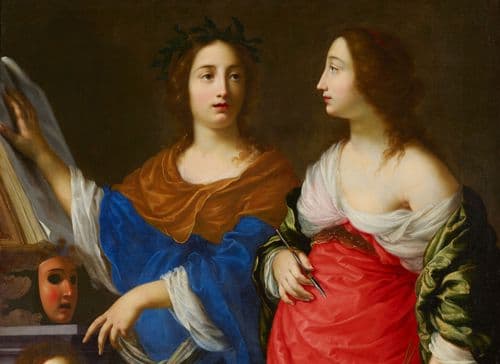
Lot 25

CESARE DANDINI (ITALIAN C.1595-1658)
ALLEGORIA DELLA COMMEDIA E DELLA PITTURA




































Auction: 15 January 2025 from 10:00 GMT
Description
oil on canvas
Dimensions
118.75cm x 101.6cm (46.75in x 40in)
Provenance
Private collection, 1965;
Art market, Rome, 1968 (according to the Zeri database);
London art market, 1983, where acquired.
Footnote
Literature:
G. Ewald, ‘Studien zur Florentiner Barockmalerei’, in Pantheon, XXIII, no. 5, 1965, pp. 308 and 311;
G. Cantelli, ‘Per Sigismondo Coccapani ‘celebre pittore fiorentino nominato il maestro del disegno’, in Prospettiva, no. 7, 1976, p. 33;
P. Bigongiari, Il caso e il caos I. Il Seicento Fiorentino tra Galileo e il ‘recitar cantando, Florence, 1982, p. 27, note 3;
G. Cantelli, ‘Mitologia sacra e profana e le sue eroine nella pittura fiorentina della prima meta del Seicento’ (II), in Paradigma, no. 4, 1982, p. 149;
G. Cantelli, Repertorio della pittura Fiorentina del Seicento, Florence, 1983, p. 57, fig. 225;
S. Bellesi, Cesare Dandini, 1996, p. 114, no. 58;
E. Leuschner, Women and Masks: the Economics of Painting and Meaning in the Mezza Figura Allegories by Lippi, Dandini and Martinelli, arthistoricum.net, 2015, p. 421, no. 6.
Cesare Dandini was an Italian painter, active mainly in his native city of Florence, who made a significant contribution to the Florentine Baroque. His bold colour contrasts and elegant, linear compositions, painted with a certain polish, displayed the Florentine tradition of artists such as Carlo Dolci.
According to the biography of Filippo Baldinucci’s (1624–1697), Cesare Dandini was a precocious artist who trained first with Francesco Curradi and then briefly with Cristofano Allori. Baldinucci writes that ‘Pietro, suo padre, decise di rimuoverlo e lo collocò con Cristofano Allori, essendo stato precedentemente con Curradi per lo spazio di tre anni interi. Ciò avrebbe aperto un ampio campo a Dandini per diventare un grande uomo imitando lo stile di quel grande maestro.’ (‘Pietro, his father, decided to remove him and placed him with Cristofano Allori, as he had already been with Curradi for three full years. This change would have given Dandini ample opportunity to become a great artist by emulating the style of that great master.’) He then went on to train with Domenico Passignano, who returned to Florence in 1616. Baldinucci also wrote that Dandini was an exceptionally beautiful youth, as seen in his Self-Portrait as a young man, and Curradi's model for numerous Madonnas, with a temperament that meant he was offended by the scurrilous activities in Allori's studio, a reaction that accords with the sense of refinement in his art. Their nephew Pietro Dandini was Vincenzo's pupil, and Pietro's two sons, Ottaviano (1681-1740) and Vincenzo (1686-1734), a Jesuit, worked as painters in Florence.
In 1621 he enrolled in the Accademia del Disegno and by 1631 he had acquired many patrons, notably Lorenzo de' Medici who would remain one of his most important supporters. He developed a theatrical, idealised style that was harmonious in form and colour and restrained in movement and expression. He shared with Florentine contemporaries Jacopo Vignali and Carlo Dolci a devotion to the style initiated in the 1590s by Lodovico Cigoli, Gregorio Pagani, Jacopo da Empoli, Domenico Passignano and Francesco Curradi and refined in the 1610s and 1620s by Matteo Rosselli, Giovanni Bilivert and Cristofano Allori, who was perhaps the most influential for Dandini. His production included everything from portraits in miniature on copper to large-scale portrayals of religious and literary themes, as well as half and three quarter length secular and allegorical figures, such as the present painting.
An Allegory of Painting and Poetry (Ut Pictura Poesis) is undoubtedly one of the most elegant and refined allegorical compositions in Dandini's oeuvre, which can be dated between the late 1640s or early 1650s. Here, two allegorical female figures are shown in conversation with one another, their statuesque poses enhanced by the marble-like beauty of their pale skin. With her head turned slightly to the right, Poetry gestures to a putto with her left hand, and rests her right hand on an open book which is placed on an ornate wooden lectern, on which a mask hangs. Her companion, the female figure of Painting, is represented with her paint brushes and a stylus in her hands. The Allegory of Painting and Poetry is an iconographic theme which was highly regarded by the Florentine painters of the seventeenth century in reference to Horace's Ars Poetica and the traditional motto of ut pictura poesis, a Latin phrase meaning ‘as is painting so is poetry’. The idea of ut pictura poesis captures the complementary nature of poetry, or writing, and painting, equating the inspiration of the poet and writer with the imagination of the painter. Both are concerned with the imitation of nature: the painter through visual elements and the poet or writer through words.




































